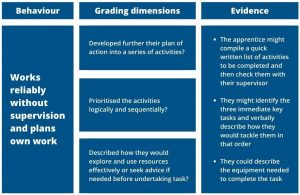
Behaviours are fundamental to all apprenticeships – every apprentice has to demonstrate particular behaviours to be successful at the end-point assessment (alongside knowledge and skills).
But for those involved in the training, behaviours can be hard to develop and difficult to quantify. They are complex and often subjective. It’s a bit like being told to dress ‘smart casual’ for a work event – you turn up in a smart dress, but your co-worker had gone for jeans and a t-shirt. Which is right? It depends on your perspective.
So how can we develop the behaviours of our apprentices? How do we build ‘behaviours’ into our curriculum and what techniques can we use?
Here’s some pointers.
Before we jump in though…
What do we mean by ‘behaviours’ in the context of apprenticeships?
The Institute for Apprenticeships and Technical Education (IfATE) describe behaviours in this way:
‘Behaviours are mindsets, attitudes or approaches required for competence, generally across the entire occupation.
Whilst these can be innate or instinctive, they can also be learnt, so they are effectively a subset of skills.
Behaviours tend to be very transferable meaning that, at any one level, they may be more similar across apprenticeship standards than knowledge and skills.’
When asking employers what they value most about their apprentice’s performance, they very often start by referencing behaviours, e.g:
- They are reliable,
- work well in the team,
- are professional with clients,
- ask when they need help.
Behaviours are central to what makes a competent and effective employee. That’s why they’re so important for apprenticeships too.
How can we build behaviours into the curriculum?
In the training phase, behaviours need to be explicitly identified and developed.
You can start to unpack the behaviour statements in standards by creating a three-column matrix that converts the behaviour statement into a set of more measurable dimensions. This will help you when considering what training and assessment methods you can use to develop and measure the apprentice’s progress. These will need developing in the workplace, so work closely with the employer.
Take a look at this example:

Next, try and imagine how the behaviour could be evidenced, through work products or written outputs. The evidence from the activities can then be judged against the assessment plan requirement or a grading matrix that you’ve developed for the on-programme phase of training.
The importance of the workplace context
According to Greg Bateson and Bob Dilts (2011 and 2014), individuals behave at three workplace organisational levels:
- Acting as an individual – behaving as yourself, naturally, unaffected and revealing your true identity (often, how you behave before you join an employer)
- Acting as a team member – loyalty within the immediate team and taking behaviour cues from the local peer network of individuals (you fit in and get on with your colleagues)
- Acting for an organisation – loyalty to the brand, identity and values of an organisation (corporate behaviours)
As you unpack each of the behaviours listed in the standard, look at how each one relates to the three areas above. How might this help you design opportunities for the apprentice to develop their behaviour as an individual, within their team and at the organisational level?
As a trainer, it’s important to align the development of behaviours to:
- workplace practices
- ways of working
- organisational culture
For instance, the behaviours shown by an apprentice in a tech start-up company will look quite different to an apprentice working for a government department.
Understanding how you can best develop the behaviours of your apprentices as an apprenticeship provider is vital. That’s why we host a deep-dive CPD session for you…
Masterclass: Developing and assessing apprentice behaviours
Join our next online Masterclass with apprenticeship expert Chris Cherry. Drawing on our work with over 5,000 trainers, the session will help you:
- Identify the apprentice’s behavioural starting point
- Map behaviours from the standard into the training plan
- Explore training techniques to develop behaviours, with the employer
- Monitor progress, assess and evidence behaviours
- Better prepare apprentices for end-point assessment
You’ll work on short activities at each stage to develop your understanding and skill. You’ll come away with a clear model you can use for the apprenticeship standards you deliver.
If you would like personalised support for your team, we also provide in-house Masterclasses for this topic. Get in touch if you’d like to know more.
